Get work done right, and right-on-time with our industry leading BPM platform.
Unleash The Power of These Amazing Document Workflow Management Software!
Workflow documents are the essence of your business operations. That’s why document workflow management software is so crucial. Well-documented processes offer insight into how operations should be run and who’s responsible for running them.
But the improper management of this documentation can lead to inefficiencies in your business operations. That’s why software is specifically designed for document workflow management.
A simple Google search will leave you with countless document workflow management software options, which can be overwhelming. I’ve rounded up the top software solutions and offered some points you should consider before settling on a purchase to make things easier.
What is document workflow management software?
Document workflow management software is designed to provide the “how” part of running a company’s processes. This documentation provides employees with the resources they need to effectively work through a workflow to reduce errors and increase productivity.
Good workflow templates are built with predefined steps that are actionable but sometimes don’t offer enough context to unfamiliar users. This workflow documentation typically lives alongside the actual workflows to offer more transparency and create a centralized knowledge base.
The best document workflow management software
Here are the top 10 best document workflow management software options to pick from:
Process Street
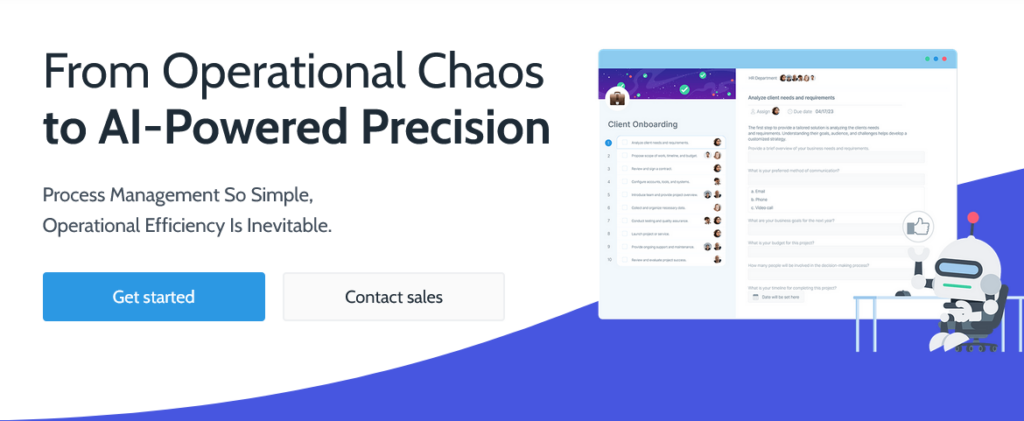
Process Street is a no-code workflow collaboration tool that creates a home for all team process documents. It’s an excellent option for companies that want to create a centralized document workflow management system where workflows can be created, run, and assigned to responsible team members.
Pros:
- Easy navigation system with a custom workflow builder
- Workflow documentation is stored alongside existing workflows
- Collaboration features improve cross-departmental communication
- Workflow automation features and integrations with other popular work applications are available
Cons:
- Pre-made template library can be confusing for users
Microsoft SharePoint
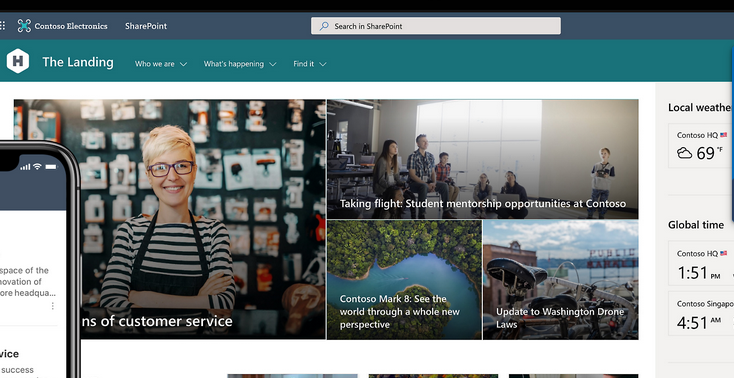
Microsoft SharePoint is used to create websites and securely store, share, organize, and access information from multiple devices. It’s well-liked as a document management and collaboration platform that empowers users to manage reports, documents, archives, and other content that teams use daily.
Pros:
- Multi-purpose functionality
- Real-time collaboration
- Offers secure external sharing
Cons:
- Difficult user interface
- Integrations with non-Microsoft workflow tools can be challenging
Google Drive
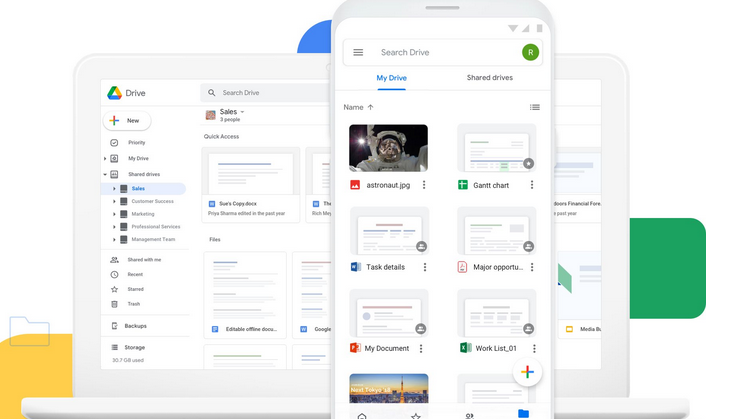
Google Drive is designed as a cloud-based program that can be used to create, store, edit, and share files. Organizations might use Google Drive as a file management system. The documents created are both accessible through the Cloud and as users’ local versions.
Pros:
- Remote collaboration between different users can be done simultaneously
- Access controls and permissions let organizations manage transparency
- Easy file navigation and user interface
Cons:
- Work in Google Drive is dependent on an internet connection
- The amount of information per day is limited
Dropbox
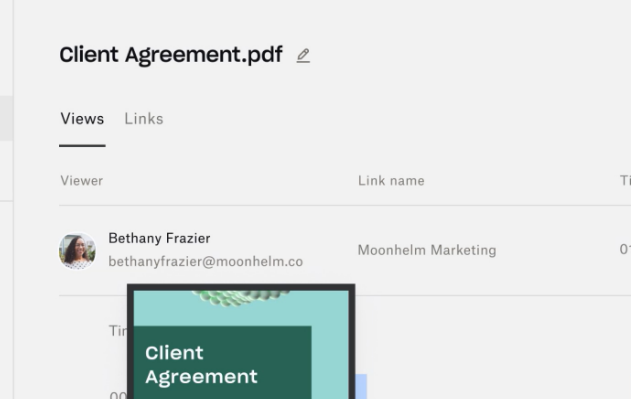
Dropbox is a cloud storage platform and is sometimes also referred to as an online backup system. It’s frequently used for collaboration and sharing and is available to users with Linux, Macintosh, and Windows desktop operating systems.
Pros:
- Cloud file backup and storage
- Syncing across devices is straightforward
- Integrations between Canva, Zoom, Slack, and more are available
Cons:
- Limited storage available for free users
- Pricing is quite costly (especially for smaller teams)
Box
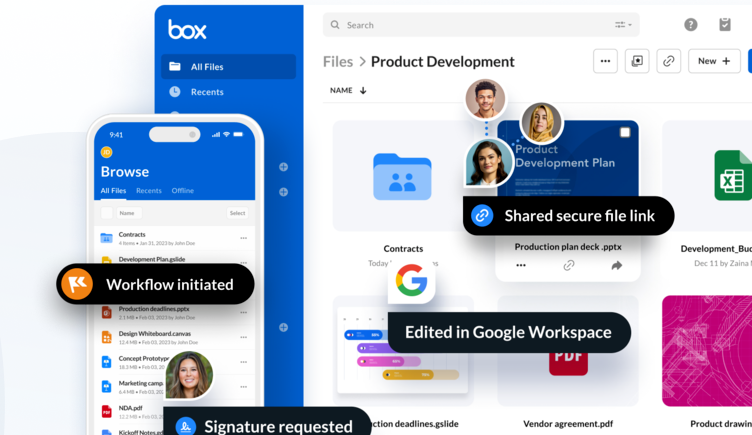
Box is a file-sharing solution that’s cloud-based and designed for enterprises to collaborate with and secure stored business documentation. Users enjoy Box for uploading files (like photos, videos, and documents) from their computer, phone, or tablet so that they can later access this documentation from anywhere.
Pros:
- Approval process control
- Activity dashboard with alerts and notifications
- Archiving and retention are available
Cons:
- Steep learning curve
- Users report failures to automatically sync information between multiple devices
OneDrive
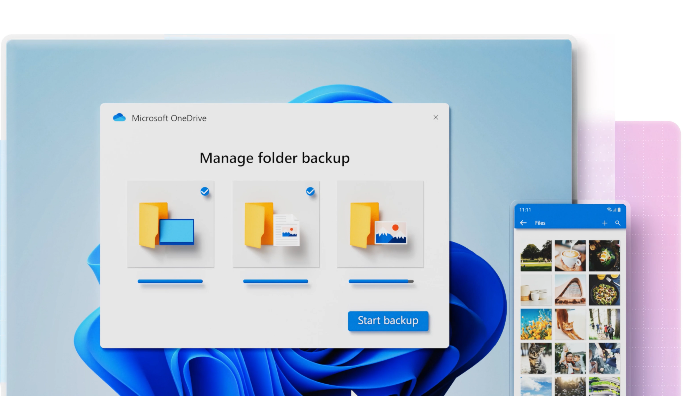
OneDrive is a Microsoft cloud service that allows companies to house all their workflow documentation. This data is stored in OneDrive and can be shared with others asynchronously through any connected devices. It’s well-liked as a backup storage device.
Pros:
- File sharing is easy
- Access control is available for added security
- Files can be shared on the Cloud with “pinned” documents saved on their local device
Cons:
- Churned employees’ data isn’t kept long-term
- There are limits to the synchronization across different devices
Egnyte
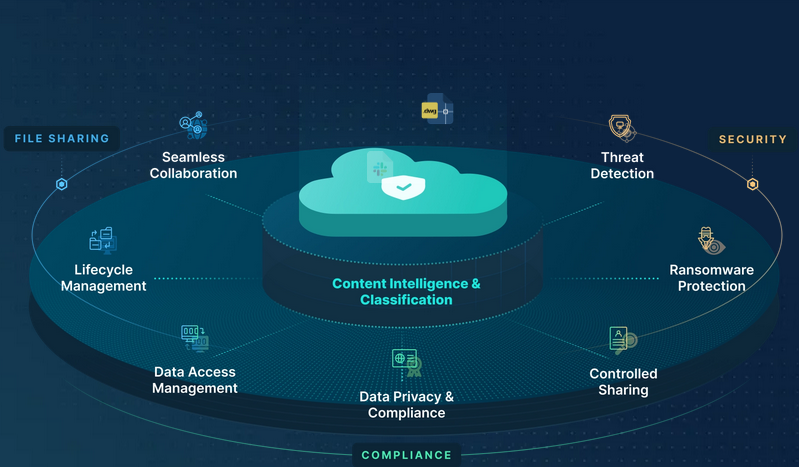
Egnyte gives users any time, anywhere access to organizational workflow documentation with real-time collaboration features. It’s well-liked as a trusted platform for secure file sharing and offers IT admins the ability to automatically classify and organize metadata.
Pros:
- Easy to use with good tech support
- Great for sharing high-resolution or graphic-heavy presentations in remote meetings
- Permission functionality allows upper management to fine-tune the accessibility of files
Cons:
- Difficulty organizing files in large numbers
- Uploading documentation into the platform can be problematic
Smartsheet
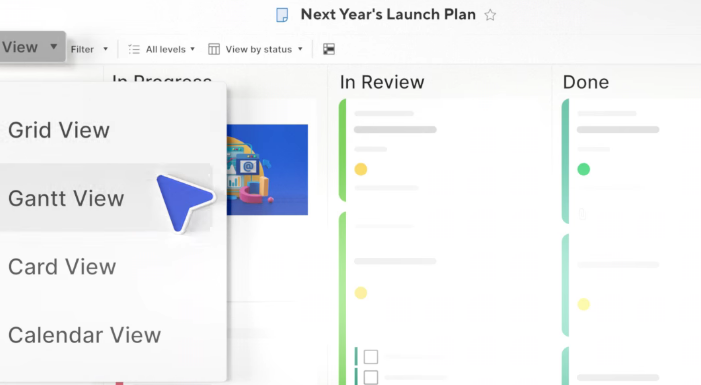
Smartsheet is a document management platform that’s well-liked for scaling from a single project to an end-to-end workflow management. It connects organizations with a no-code and cloud-based platform where all users can collaborate with one another. This project workflow management system is great for documenting workflow project information to offer more context to employees.
Pros:
- Highly customizable and has robust data compliance and protection
- Powerful reporting and analytics help users make informed decisions
Cons:
- Documentation doesn’t update in real-time
- Add-ons are needed for resource management and time tracking
- There’s a steep learning curve
Asana

Asana empowers businesses to efficiently manage their projects and the data they collect from such work activities. You’re able to organize your project documentation, collaborate with your team members, prioritize various tasks, and track your progress. It offers a place where all aspects of your project can be housed from start to finish.
Pros:
- Integrations are available with many popular work applications
- Collaboration-focused features offer a robust virtual tool for remote teams
- Task management is well-organized with real-time updates
Cons:
- It can be difficult for first-time users to master the tool
- No time-tracking features are available
Types of document workflow management software
Document workflow management software comes in different forms:
Enterprise content management (ECM) software
ECM software empowers enterprise-scale companies to intelligently manage, store, retrieve, and organize business documentation.
It’s best used for converting analogue information (like photo prints and paper documents) into digital formats.
Document management systems (DMS)
Platforms designed for document management use a computer system to track, manage, and store electronic images and documents that have been captured from a document scanner.
PDF readers are examples of DMS software and are well-liked for providing better control over sensitive documentation.
Document collaboration software
Document collaboration software empowers companies to remotely collaborate on documents in real-time.
These documents might be PDFs, spreadsheets, or text files, and can be simultaneously edited, commented on, and updated by multiple team members.
Google Docs is one example of document collaboration software.
Criteria for evaluating document workflow management software
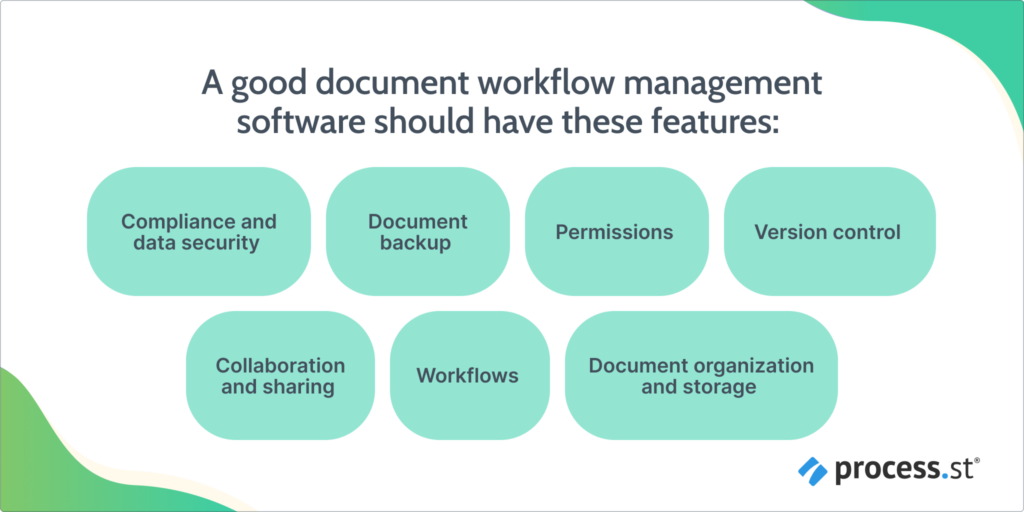
You might want a document workflow management solution that doubles as your organization’s intranet or workspace or a standalone software option.
Whatever you decide, your chosen document workflow management software should have these features:
Compliance and data security
Costly audits, damaged brand image, and significant fines can all result from mishandling your business’s and your customer’s confidential information.
That’s why your document workflow management software should be compliant with HIPAA and GDPR to ensure your information is secure. You also want your chosen software to secure data through SSL, audit trails, advanced access rights, and encryption.
Document backup
Every document workflow management software should offer the users the ability to back up their data. You want to be able to back up to the cloud or local servers either manually or automatically.
This is especially important if any collaboration is involved in your document creation. Data loss consequences can be severe and can cause reputational and financial damage without this document backup feature.
Permissions
Data breaches are always a risk but permission sets can limit information to only necessary stakeholders. You want your document workflow management software to increase visibility within your organization but you also want to have control over the level of this transparency. Permission settings can let you do that.
Version control
Documents are always being worked on. Your document workflow management software should include a version control to easily manage the numerous versions of each document. With this version control, you can manage documents throughout their lifecycle until its completion is approved. This current document can then be the single source of truth within your organization while older versions are stored.
Collaboration and sharing
The goal of using document workflow management software is to prevent unnecessary friction and information silos. Your chosen software should connect internal stakeholders and let them collaborate and share documentation. Independent contractors should also be allowed limited access to these documents so they can contribute to a specific project.
Workflows
Document workflow automation management is optimized when you’ve got actionable workflow templates living alongside your documentation. Your software should include a workflow builder where you can document and streamline your business processes.
Document organization and storage
Organizing your workflow documentation becomes more difficult as you scale. The purpose of a document workflow management system is to not spend time searching for information. Your chosen software should have a no-code, easy-to-navigate platform to make organizing and managing workflows straightforward.
How to optimize your document workflow management software
Here are the best practices to optimize your document workflow management software:
Apply automation features
You don’t just want to use a software system to create and store your workflow documentation. You also want to make the most out of the software’s automation capabilities.
This might be automating your document approval, generation, tracking, or due dates. You can save time and enhance overall efficiency when effective automation is applied to your workflow documentation.
Integrated with other work applications
It’s likely that you use many different work applications in your organization. You want to link these other applications to your document workflow management software. Information from these applications can then be sent to and from your document workflow software. This eliminates unnecessary data entry and helps you save time.
Add notifications
You want to remain up-to-date on your documents. Setting up notifications on your software system ensures you’re alerted if a document isn’t approved or if a due date has not been met. Many document workflow management software solutions are designed with email and in-app reminders. Make sure you set your notifications to set your specific preferences – either in-app, email, or both.
What is the best workflow management?
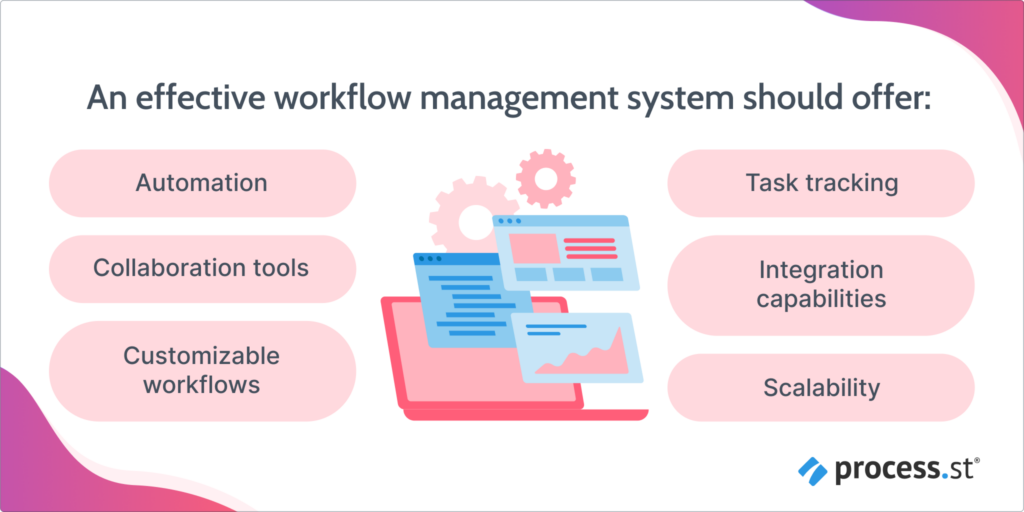
The best workflow management system varies depending on an organization’s specific needs and preferences.
However, an effective workflow management system should offer:
- Automation
- Collaboration tools
- Task tracking
- Customizable workflows
- Integration capabilities
- Scalability
Who should use document workflow management software?
Document workflow management software benefits businesses of all sizes and industries that rely on efficient document handling, collaboration, and organization.
It is particularly useful for teams or organizations dealing with a large volume of documents, requiring collaboration across different departments or locations, or needing to ensure compliance with regulations.
Examples include:
- Legal firms
- Healthcare organizations
- Marketing agencies
- Educational institutions
- Manufacturing companies
What are the four major types of workflow management?
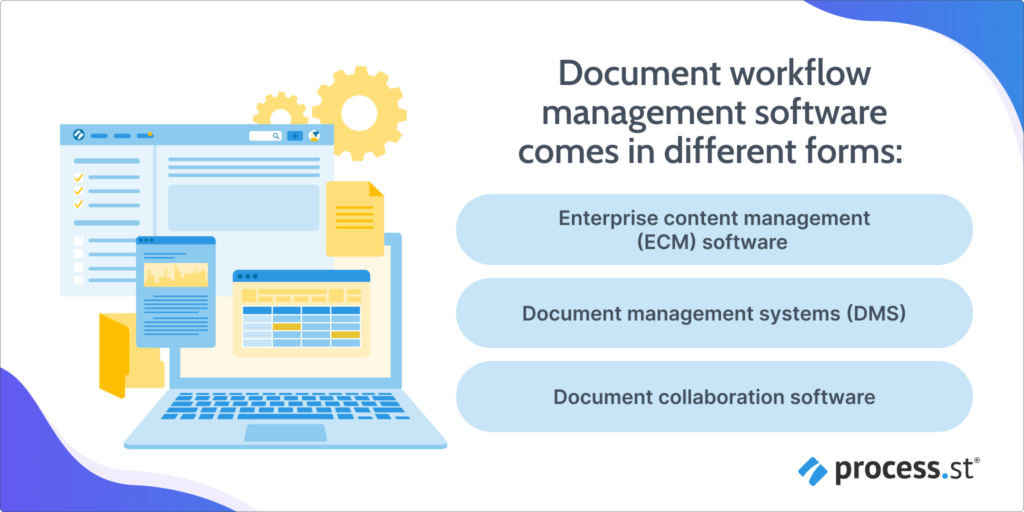
The four main types of workflow management systems are:
Enterprise content management (ECM) software
ECM software enables organizations to manage, store, retrieve, and organize business documentation intelligently. It’s suitable for converting analogue information into digital formats and is ideal for large-scale enterprises.
Document management systems (DMS)
DMS platforms track, manage, and store electronic images and documents captured from scanners. They offer better control over sensitive documentation and are commonly used for managing PDF files.
Document collaboration software
Document collaboration software facilitates real-time collaboration on documents among team members. It allows simultaneous editing, commenting, and updating of documents, making it ideal for remote teams. Examples include Google Docs.
Workflow automation software
Workflow automation software streamlines and automates business processes, reducing manual intervention and improving efficiency. It typically includes features for workflow design, task automation, and process optimization. Examples include Zapier, Microsoft Power Automate, and Nintex.
Making valuable workflow documentation accessible
Efficient document management is vital for business operations. Without a single source of truth, your team is likely to run into communication issues when working through daily business operations.
The document workflow management software you ultimately pick will give your business and its employees a single location with everything they need. No more looking through copious amounts of files. No asking around for paper documentation. No wasting valuable time and resources.
But document workflow management software can either make or break your centralized knowledge hub. That’s why it’s important to pick a solution that fits the needs of your business.
This way, you can optimize your documentation system to cater to your specific pain points and see an improvement in overall productivity and efficiency.







 Workflows
Workflows Projects
Projects Data Sets
Data Sets Forms
Forms Pages
Pages Automations
Automations Analytics
Analytics Apps
Apps Integrations
Integrations
 Property management
Property management
 Human resources
Human resources
 Customer management
Customer management
 Information technology
Information technology


